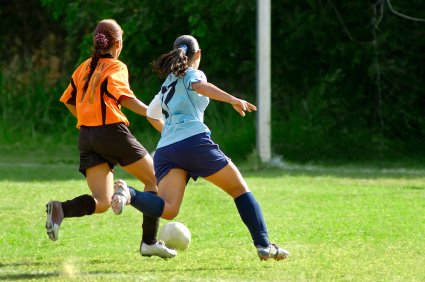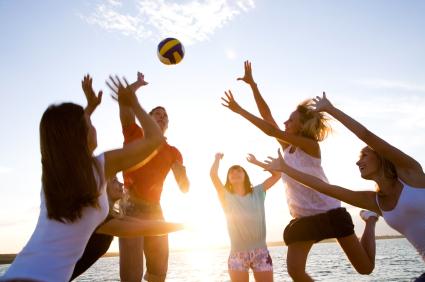One or two hours of sports each day best for teens
Playing sports is known to have a positive impact on teenagers, and a new study suggests one to two hours of playing time each day may be optimal for young people’s well-being.
Researchers found adolescents tended to be worse off if they played sports for only a couple of hours per week, or if they practiced close to three hours each day or more.
“Overtraining has not only a well-known impact on the body, but also on the brain and therefore on emotions, thoughts and mood,” Dr. Arnaud Merglen said.
“The mechanism of low activity and very high activity is probably not the same, but the results appear quite similar,” he told Reuters Health in an email.
Merglen is from the Hospital for Sick Children at the University of Toronto in Ontario and led the study, which took place at the University of Lausanne’s School of Medicine in Switzerland.
 The U.S. Centers for Disease Control and Prevention recommends children up to age 18 get at least one hour of exercise each day. But there hasn’t been much evidence on what’s best for teenagers when it comes to sports participation, according to Merglen.
The U.S. Centers for Disease Control and Prevention recommends children up to age 18 get at least one hour of exercise each day. But there hasn’t been much evidence on what’s best for teenagers when it comes to sports participation, according to Merglen.
He and his colleagues surveyed 1,245 Swiss adolescents age 16 to 20. They asked participants how much time they spent playing sports each week, among other things.
The participants also filled out a short survey on their well-being. Well-being was measured on a scale from zero to 25, with scores below 13 indicating poor well-being.
The researchers split young people into four groups based on their weekly sports practice: low (zero - 3.5 hours), average (3.6 - 10.5 hours), high (10.6 - 17.5 hours) and very high (more than 17.5 hours).
About 19 percent of the 438 teens that practiced the fewest hours reported not regularly feeling cheerful, relaxed and energized. Similarly, about 18 percent of the 60 teens that practiced the most had poor well-being.
That compared to about 9 percent of 517 adolescents in the average weekly sports group that had poor well-being and 4 percent of 230 young people in the high (but not very high) participation group.
 “Although doubling the recommended weekly time spent practicing sports to 14 hours seems to be even better for the mental and physical health of teens, going beyond this seems to be more risky,” Merglen said.
“Although doubling the recommended weekly time spent practicing sports to 14 hours seems to be even better for the mental and physical health of teens, going beyond this seems to be more risky,” Merglen said.
The study, published in Archives of Disease in Childhood, doesn’t prove exercise caused feelings of lower well-being - it only suggests a correlation.
“It’s an interesting study, and it’s a good first step, but what we really need is a study where we take thousands of five-year-olds and follow them for the next 10 to 15 years and see how kids really do based on the physical activity in which they participate,” Dr. Amanda Weiss Kelly told Reuters Health.
She is the division chief of pediatric sports medicine at University Hospitals Rainbow Babies and Children’s Hospital of Case Western Reserve University in Cleveland, Ohio.
“Exercise is really very healthy, we want kids to exercise,” said Weiss Kelly, who wasn’t involved in the new study.
“Certainly the benefits of exercise outweigh the risk for injury and other issues and I think it’s important for kids to exercise. We need to do our best to encourage kids, but also do it in a healthy way.”
Weiss Kelly noted that sports can be stressful for kids who are elite athletes and put in long hours. That stress may, at least in part, be due to the pressures put on them by coaches and parents, rather than the hours put into practice time.
“Parents really have to listen to kids about what it is they want to do to be physically active and support them in what they choose because some of the other studies on stress and sports have demonstrated that if kids are really the ones picking what they do, and how long they do it, then they tend not to get burned out,” Weiss Kelly said.
“The kids that are being pushed and feeling more pressure from parents and coaches are more likely to get burned out. I think letting kids guide the activity and be the ones in charge really helps,” she said.
SOURCE: Archives of Disease in Childhood, online November 20, 2013
###
Weekly sport practice and adolescent well-being
Objective Sport practice is widely encouraged, both in guidelines and in clinical practice, because of its broad range of positive effects on health. However, very limited evidence directly supports this statement among adolescents and the sport duration that we should recommend remains unknown. We aimed to determine sport durations that were associated with poor well-being.
Methods We conducted a survey including 1245 adolescents (16–20 years) from the general Swiss population. Participants were recruited from various settings (sport centres, peers of sport practicing adolescents, websites) and asked to complete a web-based questionnaire. Weekly sport practice was categorised into four groups: low (0–3.5 h), average (≈ recommended 7 h (3.6–10.5)), high (≈14 h (10.6–17.5)) and very high (>17.5 h). We assessed well-being using the WHO-5 Well-Being Index.
Results Compared with adolescents in the average group, those in the very high group had a higher risk of poor well-being (OR 2.29 (95% CI 1.11 to 4.72)), as did those in the low group (OR 2.33 (1.58 to 3.44)). In contrast, those in the high group had a lower risk of poor well-being than those in the average group (OR 0.46 (0.23 to 0.93)).
Conclusions We found an inverted, U-shaped relationship between weekly sport practice duration and well-being among adolescents. The peak scores of well-being were around 14 h per week of sport practice, corresponding to twice the recommended 7 h. Practicing higher sport durations was an independent risk factor of poor well-being.
Arnaud Merglen,
Aline Flatz,
Richard E Bélanger,
Pierre-André Michaud,
Joan-Carles Suris
Institute of Social and Preventive Medicine, University of Lausanne, Lausanne, Switzerland
Division of Paediatric Medicine and the Paediatric Outcomes Research Team, The Hospital for Sick Children, University of Toronto, Toronto, Canada
Division of General Pediatrics, University Hospitals of Geneva and Faculty of Medicine, University of Geneva, Geneva, Switzerland
Department of Pediatrics, Public Health Research Unit, CHUQ Medical Research Center, Laval University, Quebec City, Canada